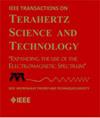Characterization of a Far-Infrared Kinetic Inductance Detector Prototype for PRIMA
IF 3.9
2区 工程技术
Q2 ENGINEERING, ELECTRICAL & ELECTRONIC
IEEE Transactions on Terahertz Science and Technology
Pub Date : 2025-03-12
DOI:10.1109/TTHZ.2024.3454436
引用次数: 0
Abstract
The PRobe far-Infrared Mission for Astrophysics (PRIMA) is under study as a potential far-IR space mission, featuring actively cooled optics, and both imaging and spectroscopic instrumentation. To fully take advantage of the low background afforded by a cold telescope, spectroscopy with PRIMA requires detectors with a noise equivalent power (NEP) better thanPRIMA远红外动力电感探测器原型的表征
探测天体物理远红外任务(PRIMA)作为一个潜在的远红外空间任务正在研究中,它具有主动冷却光学,成像和光谱仪器。为了充分利用冷望远镜提供的低背景,PRIMA光谱要求探测器的噪声等效功率(NEP)优于$1 \乘以10^{-19}$ W Hz$^{-1/2}$。为了实现这一目标,我们正在开发大型阵列的动态电感探测器(KIDs),以在25-250 $\mu$m范围内工作。在这里,我们提出了一个优化为210 $\mu$m的单像素原型探测器的设计和表征。KID由一个透镜耦合的铝电感-吸收器连接到一个铌交叉电容,形成一个2 GHz谐振器。我们制作了一个包含28个KIDs的小型阵列,并在0.01-300 aW范围内测量了其中一个探测器的光学负载的性能。在低负载下,检测器在10hz读出频率下的NEP为$9\乘以10^{-20}$ W Hz$^{-1/2}$。这些测量结果的外推表明,该探测器可以将光子噪声限制在高达20 fW的负载下,为PRIMA观测明亮的天文来源提供高动态范围。
本文章由计算机程序翻译,如有差异,请以英文原文为准。
求助全文
约1分钟内获得全文
求助全文
来源期刊

IEEE Transactions on Terahertz Science and Technology
ENGINEERING, ELECTRICAL & ELECTRONIC-OPTICS
CiteScore
7.10
自引率
9.40%
发文量
102
期刊介绍:
IEEE Transactions on Terahertz Science and Technology focuses on original research on Terahertz theory, techniques, and applications as they relate to components, devices, circuits, and systems involving the generation, transmission, and detection of Terahertz waves.
 求助内容:
求助内容: 应助结果提醒方式:
应助结果提醒方式:


